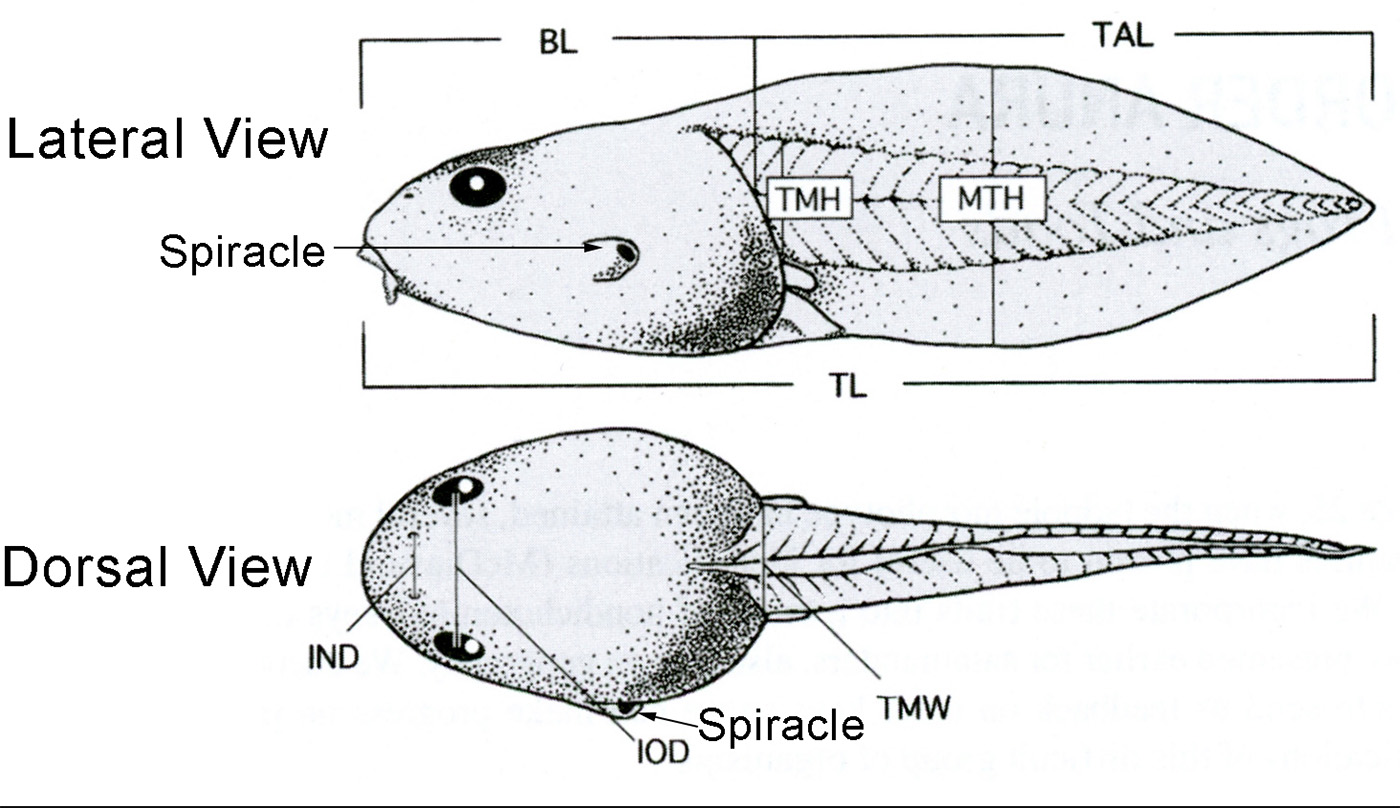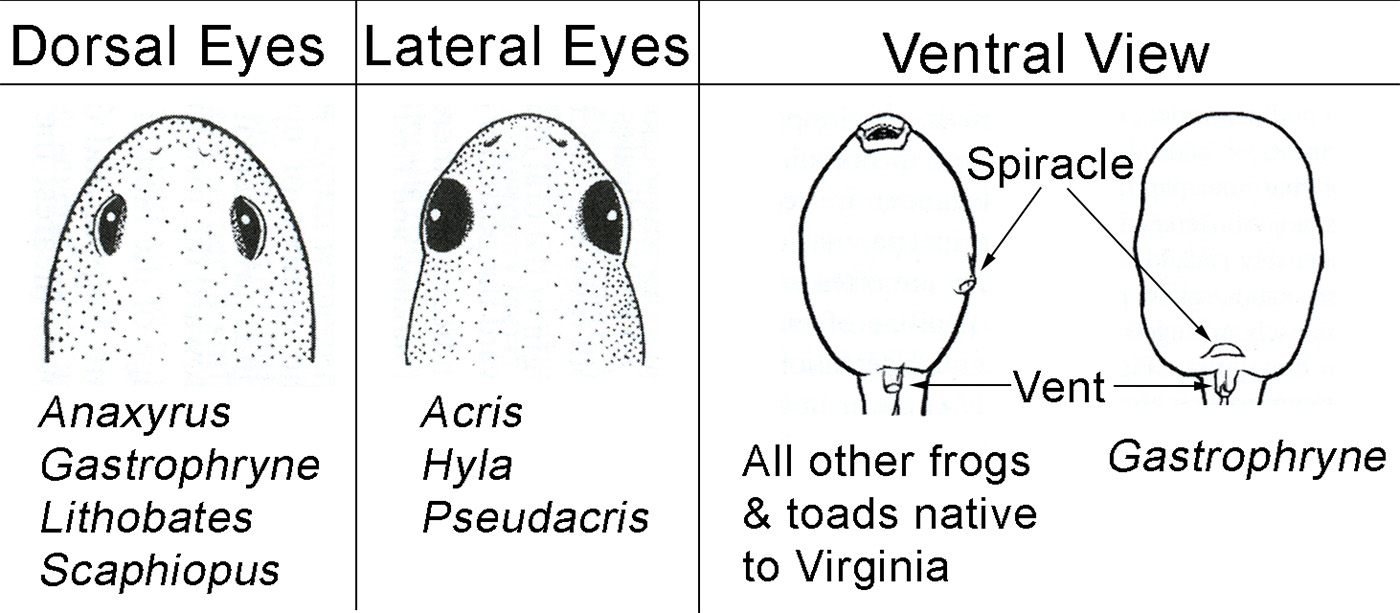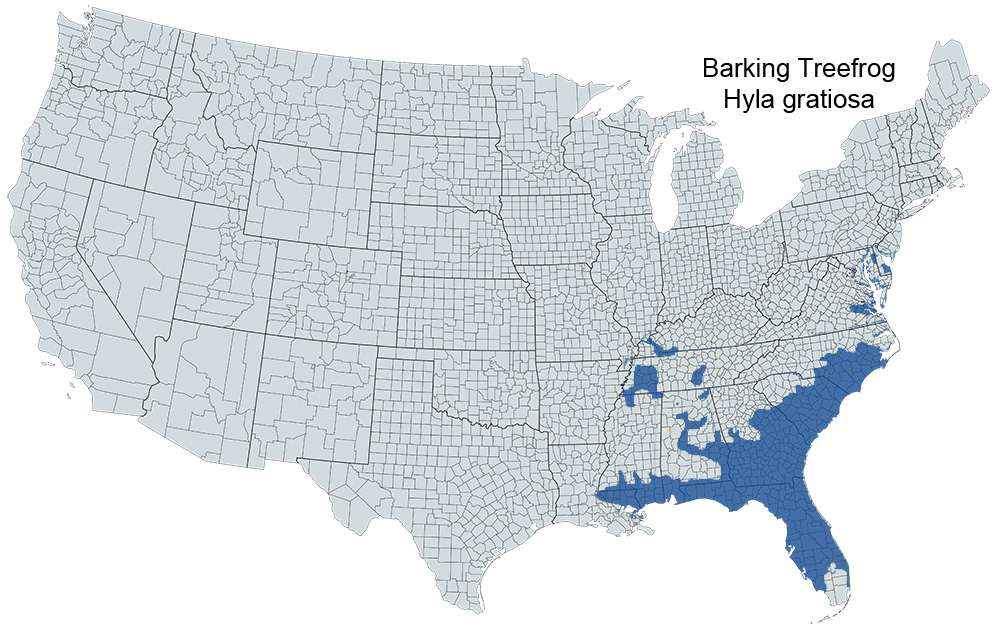Barking Treefrog
Dryophytes gratiosus
Common Name: |
Barking Treefrog |
Scientific Name: |
Dryophytes gratiosus |
Etymology: |
|
Genus: |
Dryophytes The name "Dryophytes" is derived from the Greek words "dryos," meaning tree, and "phytes," meaning plant, which refers to the arboreal habits of these frogs. |
Species: |
gratiosus is derived from the Latin word gratiosus which means "favored or pleasing". |
Average Length: |
2 - 2.6 in. (5.1 - 6.7 cm) |
Virginia Record Length: |
|
Record length: |
2.8 in. (7 cm) |
Virginia Wildlife Action Plan Rating Tier II - Very High Conservation Need - Has a high risk of extinction or extirpation. Populations of these species are at very low levels, facing real threat(s), or occur within a very limited distribution. Immediate management is needed for stabilization and recovery.
Physical Description - This species is the largest hylid frog in North America. Adults of this species range in size from 51-69 mm (2-2.75 in.). It is one of the more robust treefrog species. Sexual dimorphism is not evident. Dorsal coloration ranges from a pale green-gray to bright green to dark brown. Profuse, circular dark markings are usually present on the dorsum though they are variable and may change with background color changes. The ventrum is typically white or yellowish white. Arms are thick and muscular. There is a distinctive fold of skin on the wrists. Hands and feet are large with wide toe tips and extensive webbing. Mature tadpoles reach lengths of 34-50mm. Tadpoles can be distinguished by the following physical characteristics: very high dorsal fin, dark saddles, and a long, tapering tail tipped with a flagellum.
Historical versus Current Distribution - The historical distribution of Barking Treefrogs (Dryophytes gratiosus) was probably more widespread than is currently known. Disjunct populations in Kentucky and Tennessee, and in Maryland, Delaware, and southern New Jersey in the Atlantic Coastal Plain (Black and Gosner, 1958; Monroe and Giannini, 1977; Anderson and Dowling, 1982; Caldwell, 1982b; Arndt and White, 1988; Redmond and Scott, 1996) suggest that this species was once more widespread than it is today. Barking treefrogs currently occur in the Coastal Plain of the southeastern United States from southern New Jersey and Delaware, through southeastern Virginia, south through most of the Florida Peninsula, and westward to southeastern Louisiana (Caldwell, 1982b). Populations occur in the Piedmont of Alabama and parts of Georgia and South Carolina. Barking treefrogs are absent from most of the Atlantic Coastal Barrier Islands (Caldwell, 1982b).
Historical versus Current Abundance - Historical abundance is unknown. Estimates of current abundance range from common in North Carolina, Florida, and Louisiana, to uncommon to rare in Kentucky, Tennessee, Virginia, and northern states. Barking Treefrogs are not often encountered except after hard rains (Neill, 1958b). VanNorman and Scott (1987) reported an average of 3.3 calling males/site in Kentucky and Tennessee, but numbers of 130 males or more have been observed at breeding sites in other parts of the range of this species (Goin, 1938; personal observations). Murphy et al. (1993) reported a census population size of 1,082 adults for a site in Florida.
Life History Features - Aspects of the life history and biology of these treefrogs have been summarized by Wright (1932), Wright and Wright (1949), Murphy et al. (1993), and Murphy (1994a,b).
Breeding - Reproduction is aquatic.
Breeding migrations - Adults migrate from arboreal and terrestrial retreats to breeding sites. Mass migrations have not been reported. Neill (1958b) and Murphy (1994a) reported males entering ponds along the ground and by jumping into the water from tree branches overhanging the water.
Breeding habitat - Barking treefrogs breed in a wide variety of shallow wetlands, including ephemeral pools, semi-permanent ponds, and permanent ponds. Observed habitats include corn fields, cypress ponds, acid bogs, flooded ditches, swamps, flooded sand pits, woodland ponds, sinkhole ponds, Carolina bays, live oak hammock wetlands, human impoundments surrounded by fields, and backwaters of streams (see summaries in Wright and Wright, 1949; Mount, 1975; VanNorman and Scott, 1987). Most populations occur in wetlands with aquatic vegetation. Wetlands with fish are seldom used for breeding.
The breeding period occurs from mid June to late July in Kentucky (VanNorman and Scott, 1987); late April to July in Alabama and North Carolina (Mount, 1975; personal observations); mid March to mid August in Louisiana (Dundee and Rossman, 1989); and March–August in Florida (Murphy, 1994a). Initial dates of calling vary due to temperature and dry versus wet conditions; calling dates were 25 May–18 June in one North Carolina population (Travis, 1983b). Males call from perches on vegetation in and out of the water, but primarily while floating on the water's surface. Neill (1958b) described the barking call given from arboreal perches during the day and the breeding call produced when calling from water. Carr (1940a) noted that the barking call was heard in Florida from 1 March–23 October. In Florida, breeding is sporadic until mid April after which it is nearly continuous with females mating on 72–95% of the nights during this period (Murphy, 1994a). Most males are present for ≤ 8 nights at a breeding site, but some are present for as many as 26–46 nights (Murphy, 1994b). However, Travis (1983b) stated that nearly all eggs are laid on two nights in North Carolina. Brandt (1936a) noted egg laying as late as 7 August in North Carolina. Females select males in vegetation and in water, and ovulation occurs only after amplexus is initiated (Fortman and Altig, 1973). Amplexus lasts from 5 hr to all night and females move around the pond while depositing eggs (Travis, 1983b; Murphy, 1994b). Both sexes move to the surrounding vegetation after mating. Females are not known to produce > 1 clutch/yr. Amplexus, or a cue associated with amplexus, triggers oviposition (Scarlata and Murphy, 2003).
Egg deposition sites - Females deposit eggs singly on the substrate of the breeding pond (Livezey and Wright, 1947; Travis, 1983b).
Clutch size - Females lay about 1,500–4,000 eggs (Livezey and Wright, 1947; Travis, 1983b). Number of eggs laid is positively correlated with time spent in amplexus (Scarlata and Murphy, 2003).
Altig & McDiarmid 2015 - Classification and Description:
- Eastern Clump
- Arrangement 1 - Eggs oviposited as small clumps, not well formed, surface irregular and not distinctly lobate, eggs often fall apart as singles soon after oviposition.
- Sub-arrangement B - Eggs deposited in permanent and ephemeral nonflowing water with emergent vegetation; Ovum Diameter 0.8-1.6 mm; Egg Diameter 3.6-4.0 mm; 2 layers.
- Arrangement 1 - Eggs oviposited as small clumps, not well formed, surface irregular and not distinctly lobate, eggs often fall apart as singles soon after oviposition.
Larvae/Metamorphosis - The large and uniquely shaped tadpoles develop in 41–160 d (Wright, 1932; Travis, 1984; Dundee and Rossman, 1989) and metamorphose in June–August, depending on latitude, pond hydrology, and temperature. Tadpole densities reach 4–8/m2 in some ponds (Caldwell et al., 1980). Survivorship in field enclosures was 0.1–0.22 and varied due to invertebrate densities (Travis, 1983a). Size at metamorphosis is 18–28 mm SVL and is affected by food availability, genetic relationships, and temperature (Travis, 1980a,b; Dundee and Rossman, 1989; Leips and Travis, 1994).
Tadpoles:

| Lateral View | Dorsal View |
|---|---|
| BL = Body Length | IND = Internarial Distance |
| MTH = Maximum Tail Height | IOD = Interorbital Distance |
| TAL = Tail Length | TMW = Tail Muscle Width |
| TL = Total Length | |
| TMH = Tail Muscle Height |

Juvenile Habitat - Juveniles remain in low vegetation following metamorphosis, sometimes dispersing widely from natal ponds.
Adult Habitat - Adult Barking Treefrogs remain in trees and shrubs or burrow into damp sand under logs or grass tussocks around the pond border when they are not engaged in calling or reproduction in water (Neill, 1952, 1958b). Neill (1952) found them no more than 1.5 m above ground on vegetation, but I have seen them about 2.5 above ground on tree limbs. Murphy (1994a) reported movements of 100 m between breeding ponds by several males in Florida.
Home Range Size - Home range size is unknown.
Territories - Barking Treefrogs do not maintain or defend territories.
Aestivation/Avoiding Dessication - Aestivation occurs during dry periods in summer. Neill (1952) noted that Barking Treefrogs aestivate in sandy soil beneath grass tussocks.
Seasonal Migrations - Barking Treefrogs do not migrate seasonally, but remain in the vicinity of breeding sites.
Torpor (Hibernation) - Barking Treefrogs burrow into sandy substrates in Georgia and Florida and use Gopher Tortoise (Gopherus polyphemus) burrows and other burrows for overwintering, although Neill (1952) suggested that they may dig backwards similar to toads to create their own subterranean retreats. Carr (1940a) found adults 1.2 m below the surface. Lee (1968b) found adults in Florida gopher mouse (Peromyscus floridanus) burrows.
Interspecific Associations/Exclusions - This species occurs with other frogs that use shallow wetlands for breeding, including Eastern Cricket Frogs (Acris crepitans), Southern Cricket Frogs (Acris gryllus), Fowler's Toads (Anaxyrus fowleri), Southern Toads (Anaxyrus terrestris), Eastern Narrow-mouthed Toads (Gastrophryne carolinensis), Cope's Gray Treefrogs (Dryophytes chrysoscelis), Gray Treefrogs (Dryophytes versicolor), Green Treefrogs (Dryophytes cinerea), Pine Woods Treefrogs (Dryophytes femoralis), Squirrel Treefrogs (Dryophytes squirellus), Brimley's Chorus Frogs (Pseudacris brimleyi), Spring Peepers (Pseudacris crucifer), Upland Chorus Frogs (Pseudacris feriarum), American Bullfrogs (Lithobates catesbeiana), Green Frogs (Lithobates clamitans), and Coastal Plains Leopard Frog (Lithobates sphenocephalus utricularius; de Rageot, 1969; VanNorman and Scott, 1987; personal observations). Syntopic salamanders include Mabee's Salamanders (Ambystoma mabeei), Mole Salamanders (Ambystoma talpoideum), tiger salamanders (Ambystoma tigrinum), and eastern newts (Notophthalmus viridescens).
Mecham (1960b), Gerhardt et al. (1980), and Lamb and Avise (1986, 1987) evaluated hybridization between Barking Treefrogs and Green Treefrogs in Alabama and Georgia.
Age/Size at Reproductive Maturity - Age at sexual maturity is unknown for Barking Treefrogs. VanNorman and Scott (1987) reported that the smallest adult male was 45 mm SVL; the smallest adult female 57 mm.
Longevity - Maximum known longevity for a captive adult was 10 yr, 3 mo (Snider and Bowler, 1992).
Feeding Behavior - These gape-limited predators eat anything that they can swallow. Murphy et al. (1993) found that prey in 30 adult males represented nine orders from three classes of arthropods, with the majority being insects and beetles (Coleoptera) being the most common insect taxa. Barking treefrogs are opportunistic foragers, consuming arboreal and terrestrial prey.
Predators - Known predators of Barking Treefrogs are dragonfly naiads, Mole Salamanders (Ambystoma talpoideum), Banded Watersnakes (Nerodia fasciata), Cottonmouths (Agkistrodon piscivorus), and Southern Hog-nosed Snakes (Heterodon simus; Neill, 1952; E.E. Brown, 1979; Caldwell et al., 1980).
Anti-Predator Mechanisms - Adults inflate with air when disturbed but are not known to be toxic. Small tadpoles have a black saddle in the middle of the tail musculature (Altig, 1972b) that may direct predators away from the body. Caldwell et al. (1980) found that tadpoles showed an average immobile response time of > 4 min when predation was simulated. When frightened or prodded, tadpoles initially dart off, then sink slowly a short distance as they become immobile (Caldwell et al., 1980).
Diseases - None reported, although Mitchell and Green (2003) recently documented an intestinal hernia representing a developmental malformation.
Parasites - None reported.
Conservation - Barking treefrogs are locally common throughout much of their range from North Carolina southward. However, this species is listed as state Endangered in Delaware, and legally Protected in Maryland and Tennessee (Levell, 1997). Disjunct populations in Kentucky are not protected. Habitat loss and the small number of occurrences contribute to their protected status in the northern portions of their range.
Murphy et al. (1993) made three management recommendations for a location in central Florida: (1) decisions on this species should be based on estimates of effective population size and not short-term census results; (2) multiple ponds in the landscape should be protected because Barking Treefrogs migrate among breeding sites; and (3) habitats between breeding ponds should be protected to allow dispersal. Similar recommendations would be appropriate for other areas where Barking Treefrogs breed in complexes of ponds.
References for Life History
- Altig, Ronald & McDiarmid, Roy W. 2015. Handbook of Larval Amphibians of the United States and Canada. Cornell University Press, Ithaca, NY. 341 pages.
- AmphibiaWeb. 2020. University of California, Berkeley, CA, USA.
- Conant, Roger and, Collins, John T., 2016, Peterson Field Guide: Reptiles and Amphibians, Eastern and Central North America, 494 pgs., Houghton Mifflin Company., New York
- Duellman, William E. and, Trueb, Linda, 1986, Biology of Amphibians, 671 pgs., The Johns Hopkins University Press, Baltimore
- Martof, B.S., Palmer, W.M., Bailey, J.R., Harrison, III J.R., 1980, Amphibians and Reptiles of the Carolinas and Virginia, 264 pgs., UNC Press, Chapel Hill, NC
- Wilson, L.A., 1995, Land manager's guide to the amphibians and reptiles of the South, 360 pp. pgs., The Nature Conservancy, Southeastern Region, Chapel Hill, NC
Photos:
*Click on a thumbnail for a larger version.
Verified County/City Occurrence
Amelia
Brunswick
Chesterfield
Dinwiddie
Gloucester
Greensville
Isle of Wight
Lunenburg
Mathews
Nottoway
Prince Edward
Prince George
Southampton
Surry
Sussex
York
CITIES
Suffolk
Virginia Beach
Verified in 16 counties and 2 cities.
U.S. Range






1242_small.jpg)
18b-sm.jpg)
01-sm.jpg)



